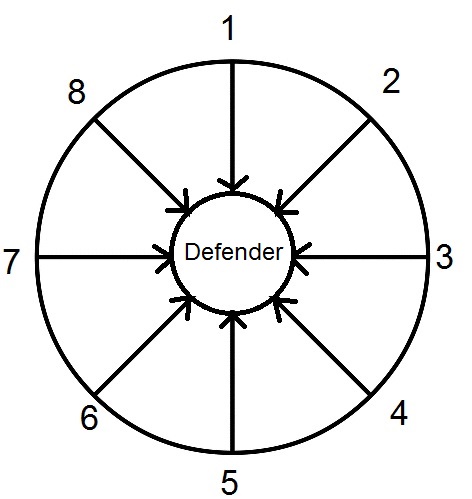"Coaching The SKU Way!" Official SKU Coaching Resource
First Published Aug 2013 Issue 52 SKU Quarterly Magazine
Happo Kumite 八方組み手
by Derick Kirkham
Happo Kumite 八方組み手
Translation: Eight-direction sparringHappo Kumite means Eight-direction sparring, the 4 cardinal & the 4 ordinal directions. It is a member of the Oyo Kumite group, which is a subset of the Yakusoku Kumite group. A commonly held and ill-informed misconception of Happo Kumite is that it means four directional sparring. This is due in the main to it usually being practiced using four attacking opponents. However, its name comes from its purpose, which is to allow the practice of your self-defence techniques from all of the 8 possible directions of attack, from a more self-defence orientated perspective. It was originally practiced by forming a circle and placing eight attacking opponents on the circumference of the circle at eight equally distanced points. The defender stands alone in the centre of the circle and comes under constant attack for a period of 30 seconds up to 2 minutes for the more advanced Karate-ka.

It seems that its purpose and practice in its traditional form has been abandoned somewhat of late in favour of using a redefined version of the drill, which has been designed to improve the reflex action and decision making of the Karate athlete for point scoring in a Kyogi Sport Kumite setting.
The Happo Kumite format can be used to practice and add another dimension to your, Kihon Ippon Kumite, Jiyu Ippon Kumite, Kaeshi Ippon Kumite, Jiyu Kumite, Oyo Kumite and latterly Kyogi practice. While the mental preparation to engage in any form of Kumite does share some basic instinct requirements, there are specific requirements to be added dependent upon the form of Kumite to be practiced. This is why much Happo Kumite practice breaks down and highlights the lack of understanding of the form of Kumite being attempted and the lack of the participant’s preparation.
Too often Happo Kumite practice is entered into by unprepared & uncomfortable participants, in a rushed manner, and the whole drill is lacking in discipline, understanding, co-ordination, and displays an element of reluctance by the 4 attackers, and a high degree of panic which sometimes is bordering upon fear by the defender, which renders the whole drill ineffective, non-productive and definitely poor practice.
To avoid the breakdown of the drill it is paramount that one understands the principles of the form of kumite that one is about to practice, what are the aims of that form of kumite and one should be familiar and confident with practicing the form in a 1 on 1 situation, long before one steps in to practicing it in a Happo Kumite format.
Ones expectation of oneself when practicing Happo Kumite for the first time should be realistic, and one should leave ones false impression of one’s ability in the changing room, if unfettered progress is to be achieved. One should not be practicing Happo Kumite with the intention of demonstrating ones supremacy over 4 other people to an audience. The intent is to improve on one’s ability to react and to manage multiple attacks and directional changes. One should not get confused over or mix and match the aims of the form of Kumite that one is practicing in the Happo Kumite circle
Good Luck and Good Practice.
